Related Research Articles

Frederick I was King of Denmark and Norway. He was the last Catholic monarch to reign over Denmark and Norway, when subsequent monarchs embraced Lutheranism after the Protestant Reformation. As king of Norway, Frederick is most remarkable in never having visited the country and was never crowned as such. Therefore, he was styled King of Denmark, the Vends and the Goths, elected King of Norway. Frederick's reign began the enduring tradition of calling kings of Denmark alternatively by the names Christian and Frederick.

The Prince-Archbishopric of Bremen — not to be confused with the modern Archdiocese of Hamburg, founded in 1994 — was an ecclesiastical principality (787–1566/1648) of the Holy Roman Empire and the Catholic Church that after its definitive secularization in 1648 became the hereditary Duchy of Bremen. The prince-archbishopric, which was under the secular rule of the archbishop, consisted of about a third of the diocesan territory. The city of Bremen was de facto and de jure not part of the prince-archbishopric. Most of the prince-archbishopric lay rather in the area to the north of the city of Bremen, between the Weser and Elbe rivers. Even more confusingly, parts of the prince-archbishopric belonged in religious respect to the neighbouring Diocese of Verden, making up 10% of its diocesan territory.

The archbishop of Cologne governs the Roman Catholic Archdiocese of Cologne in western North Rhine-Westphalia. Historically the archbishop was ex officio one of the prince-electors of the Holy Roman Empire and ruled the Electorate of Cologne.
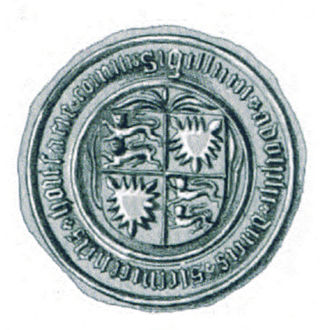
Adolphus XI of Schauenburg, as Adolph I Duke of Schleswig, and as Adolph VIII Count of Holstein-Rendsburg, was the mightiest vassal of the Danish realm.

Hedvig of Holstein was a duchess of Schleswig and a countess of Holstein from the family of Schauenburg. She was the mother of King Christian I of Denmark and ancestor of the Danish Royal houses of Oldenburg and Schleswig-Holstein-Sonderburg-Glücksburg.
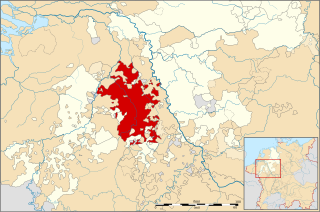
The Duchy of Jülich comprised a state within the Holy Roman Empire from the 11th to the 18th centuries. The duchy lay west of the Rhine river and was bordered by the Electorate of Cologne to the east and the Duchy of Limburg to the west. It had territories on both sides of the river Rur, around its capital Jülich – the former Roman Iuliacum – in the lower Rhineland. The duchy amalgamated with the County of Berg beyond the Rhine in 1423, and from then on also became known as Jülich-Berg. Later it became part of the United Duchies of Jülich-Cleves-Berg.
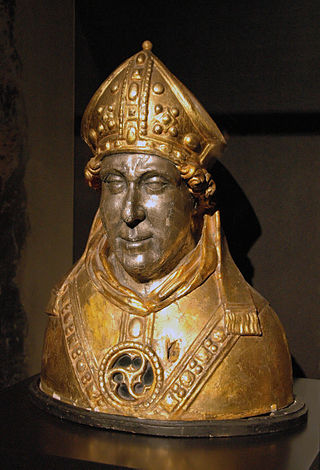
Count Engelbert II of Berg, also known as Saint Engelbert, Engelbert of Cologne, Engelbert I, Archbishop of Cologne or Engelbert I of Berg, Archbishop of Cologne was archbishop of Cologne and a saint; he was notoriously murdered by a member of his own family.
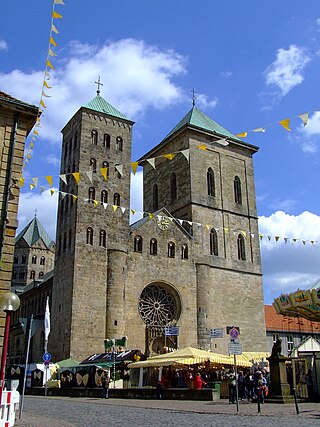
The Diocese of Osnabrück is a Latin Church ecclesiastical territory or diocese of the Catholic church in Germany. The diocese was originally founded circa 800. It should not be confused with the smaller Prince-Bishopric of Osnabrück–an ecclesiastical principality of the Holy Roman Empire until 1803–over which the bishop, as prince-bishop, exercised both temporal and spiritual authority.

The Counts of Schauenburg and Holstein were titles of the Holy Roman Empire. The dynastic family came from the County of Schauenburg near Rinteln on the Weser in Germany. Together with its ancestral possessions in Bückeburg and Stadthagen, the House of Schauenburg ruled the County of Schauenburg and the County of Holstein. The comital titles of Holstein were subject to the liege lord, the Dukes of undivided Saxony until 1296, and thereafter the Dukes of Saxe-Lauenburg.

Otto IV of Schaumburg was a German nobleman. He was a ruling Count of Schauenburg and of Holstein-Pinneberg. He was a son of Jobst I and his wife Mary of Nassau-Siegen, a daughter of Count John V of Nassau-Siegen.

The Prince-Bishopric of Paderborn was an ecclesiastical principality (Hochstift) of the Holy Roman Empire from 1281 to 1802.

Mechtilde of Holstein was a Danish queen consort, married to King Abel of Denmark and later to Birger Jarl, Regent of Sweden.
Adolf IV, was a Count of Schauenburg (1225–1238) and of Holstein (1227–1238), of the House of Schaumburg. Adolf was the eldest son of Adolf III of Schauenburg and Holstein by his second wife, Adelheid of Querfurt.

Adolf III, Count of Schauenburg and Holstein was the ruler of the Counties of Schauenburg and Holstein. He is particularly remembered for his establishment of a new settlement for traders on the banks of the Alster near the Neue Burg in Hamburg.
Adolf III of Schauenburg (1511-1556) was the Archbishop-Elector of Cologne from 1547 to 1556.

The County of Holstein-Pinneberg, also known as the County of Schauenburg and Holstein-Pinneberg, was a small territory which existed from 1290 until 1640, centred around Pinneberg in modern-day Schleswig-Holstein, Germany.
Jobst I, Count of Holstein-Schauenburg (1483-1531) was a German nobleman. He was the ruling Count of Schauenburg and Holstein-Pinneberg from 1527 until his death. He was a son of John IV and his wife, Cordula of Gemen.

Countess Mary of Nassau-Siegen, German: Maria Gräfin von Nassau-Siegen, official titles: Gräfin zu Nassau, Vianden und Diez, was a countess from the House of Nassau-Siegen, a cadet branch of the Ottonian Line of the House of Nassau, and through marriage Countess of Holstein-Schauenburg-Pinneberg.
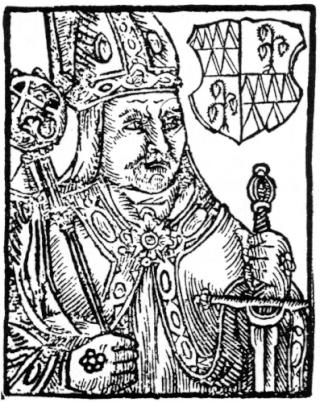
Bruno von Schauenburg was a nobleman and Catholic priest of German descent, bishop of Olomouc in 1245–1281. He was one of the main advisors and diplomats of the Czech kings: Wenceslaus I of Bohemia, and especially Ottokar II of Bohemia, for whom he was the "right hand". As a bishop in history of Moravia he is known thanks to colonization and his role in founding many new towns.
References
- This page is based on this page on German Wikipedia.
- ↑ Catholic Hierarchy website, profile page
- ↑ Catholic Hierarchy website, Archdiocese of Cologne page
- ↑ New Advent website, Cologne page Adolph III of Schauenburg (1546-56) took strong measures against the preachers brought in by Hermann, and published vigorous decrees against immoral priests. His brother Anton (1556-58) followed a similar course.